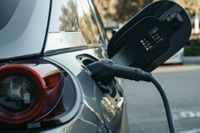Concerns Raised About Roadside Guardrail Safety for Heavy Electric Vehicles
Preliminary crash test data released by the University of Nebraska is raising concerns about the effectiveness of traditional guardrails in protecting heavy electric vehicles. The tests showed that guardrails designed to withstand the force of gas-powered vehicles can do little to stop electric vehicles, which typically weigh more and have lower centers of gravity. The results highlight the need for engineering solutions that address the weight disparity between electric and gas-powered vehicles.

Guardrails Prove Inadequate for Heavy Electric Vehicles
According to crash test data from the University of Nebraska, electric vehicles are capable of crashing through steel highway guardrails that are not designed to withstand their extra force. Electric vehicles typically weigh 20% to 50% more than gas-powered vehicles due to the weight of their batteries. This weight difference, coupled with the lower center of gravity of electric vehicles, makes guardrails ineffective in preventing them from pushing through barriers.
During a recent crash test, a 4-ton electric pickup truck tore through a metal guardrail without significant damage to its interior. This highlights the potential danger heavy electric vehicles pose to lighter gas-powered vehicles in collisions. While electric vehicles offer superior protection to their own occupants, the weight disparity poses a safety risk to other drivers.
The results of the crash test raise concerns about the nation's roadside safety system and the need for updated engineering solutions that can handle the increasing number of heavy electric vehicles on the road.
Guardrails Are Essential for Road Safety
Guardrails play a crucial role in preventing passenger vehicles from leaving the road in critical areas, such as bridges, cliffs, and ravines. They are a safety feature of last resort, designed to minimize the likelihood of injury and death in off-the-road crashes.
However, the weight of electric vehicles poses a challenge to the effectiveness of guardrails. With the rising popularity of heavy electric vehicles weighing around 7,000 pounds, it becomes necessary to address this weight disparity. The University of Nebraska's crash test results emphasize the urgency of finding engineering solutions to ensure the safety of all vehicles on the road.
Previous experiences with the changing makeup of vehicles, such as the increase in pickup trucks and SUVs, have demonstrated the need to adapt guardrails to accommodate new vehicle types. The challenge lies in determining the scope of changes required and updating the infrastructure accordingly.
Collaboration Needed for Solutions
Addressing the weight disparity between electric and gas-powered vehicles requires collaboration between transportation engineers and vehicle manufacturers. As electric vehicles continue to gain popularity and make up a larger percentage of new vehicle sales, the need for compatible roadside barriers becomes more prevalent.
Further testing, including computer simulations and crash tests of more electric vehicles, is planned to determine the best engineering approaches. To ensure the safety of both electric and gas-powered vehicles, it is crucial to find effective solutions that minimize the impact of crashes.
While the weight disparity issue extends beyond guardrails, affecting infrastructure like parking garages and residential streets, collaboration and innovation can lead to the necessary changes and updates to accommodate the evolving vehicle landscape.


